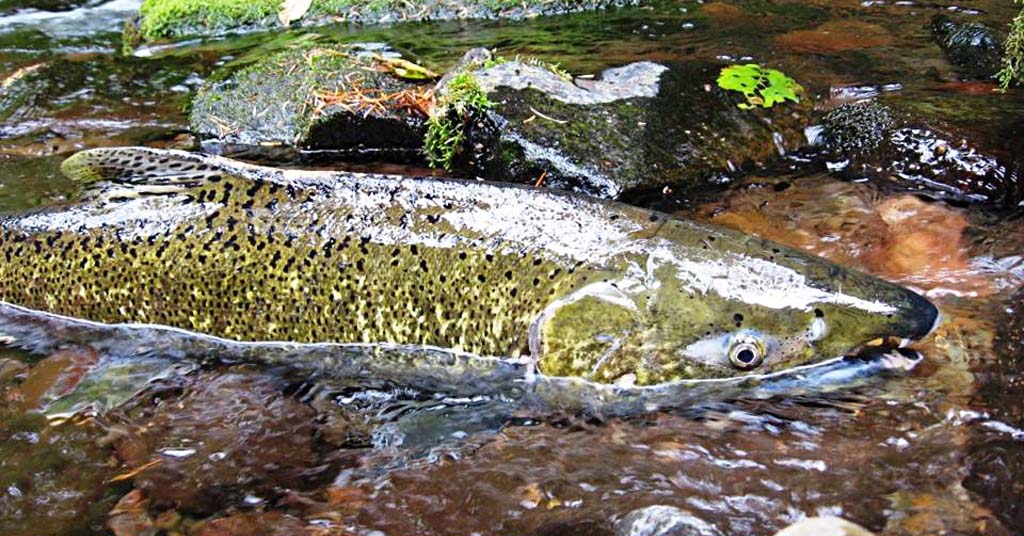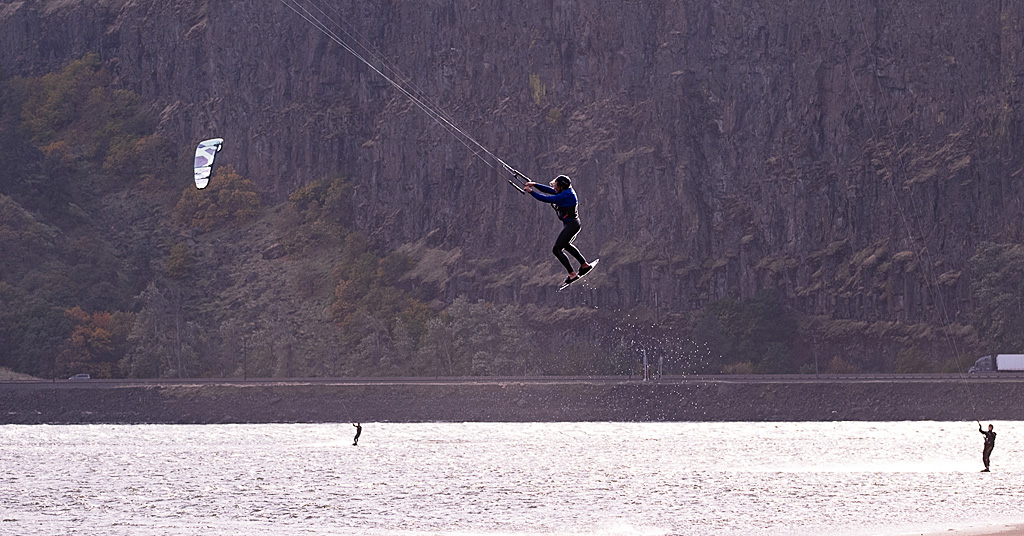In the Yakima Basin, irrigators and the Yakama Nation are investigating how reservoirs can be used to create artificial currents that mimic natural ones

Keeping current: Changes are happening around the Yakima River Basin. Phil Rigdon of the Department of Natural Resources for the Yakama Nation pays attention to them all. Photo: Steven Gnam
By Nathan Gilles. December 15, 2022. There’s no question. She’s going for it. She’s just biding her time.
Swimming in a pool of slow-moving water surrounded by swift currents, a roughly two-foot-long coho salmon appears to be assessing her next move.
Ahead of her is a low spot where the pebbly rocks lining the stream bed peak to the surface as the water rises before disappearing again as the water drops with the current.
The difference in water depth is subtle—no more than a couple of inches—but this expert at swimming upstream seems to notice. She waits for the right moment to cross the shallows obstructing her journey.
It’s November in central Washington state’s Yakima River Basin on the eastern edge of the Cascade mountains.
Much of the lower basin falls well within the mountain range’s rain shadow and is dominated by grasses, sagebrush and irrigated agriculture.
But here in the higher elevations of the upper basin I’m surrounded by forests of green firs, cedars and pines.
The cool fall weather has yellowed the leaves of the maples, aspens and cottonwoods. And the needles of the larches, the region’s native deciduous conifers, are showing the rich ocher of their autumn color.
The stream in front of me, the one with the patient coho, is flowing fast. But it shouldn’t be. The annual fall rains haven’t arrived yet.
This small stream, aptly named Little Creek, should be bone dry.
But this oddity is exactly why I’m here. Little Creek could hold a glimpse into a hopeful future, one in which salmon can weather decades if not centuries of climate change.
This future will require a combination of human ingenuity and cooperation. It’s a future that blurs the line between natural and artificial.
I’m skeptical, but I’m willing to be surprised.
Unlikely coalition
Urban Eberhart is my first surprise.
He’s passionate about protecting the Yakima Basin’s salmon. What’s more, the organization he runs has performed some of the basin’s most important salmon conservation work.
But he’s not a professional environmentalist. He runs an irrigation district.
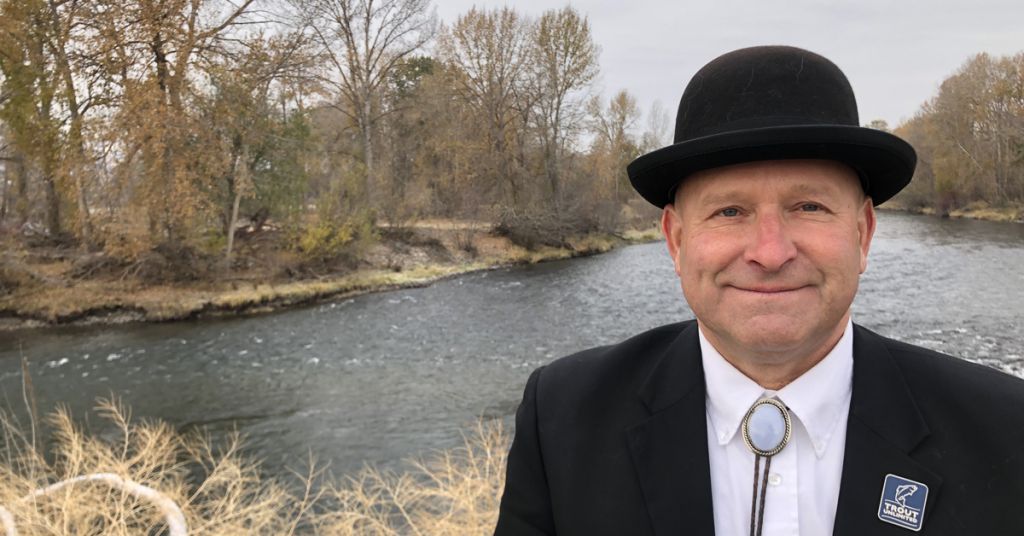
Team player: Urban Eberhart is helping pull together a surprising alliance of leaders around the Yakima River. Photo: Nathan Gilles
Urban Eberhart is the water manager for the Kittitas Reclamation District (KRD) and my guide for the day. He’s dressed in a black bowler hat, black boots, a long black coat, a white button-down shirt and a bolo tie, in the center of which sits a polished Ellensburg blue agate—a stone found only northwest of nearby Ellensburg, Washington.
Eberhart’s primary job is making sure farmers and other water users in his district get the water they’re entitled to by law.
Today, he’s giving me a tour of the work he and his colleagues have been doing to use dams to help struggling and endangered salmon in the basin.
You read that right. Eberhart and his team at the irrigation district are using the very thing that helped decimate Pacific salmon numbers to help bring them back.
In recent years, Eberhart has been at the vanguard of something entirely new.
He and others in the basin—including other irrigation district leaders, nonprofit environmentalists, and even the basin’s original inhabitants, the Confederated Tribes and Bands of the Yakama Nation—have been experimenting with selectively releasing water from the basin’s dams and reservoirs to help both adult salmon reach their spawning grounds and juvenile salmon reach the ocean.
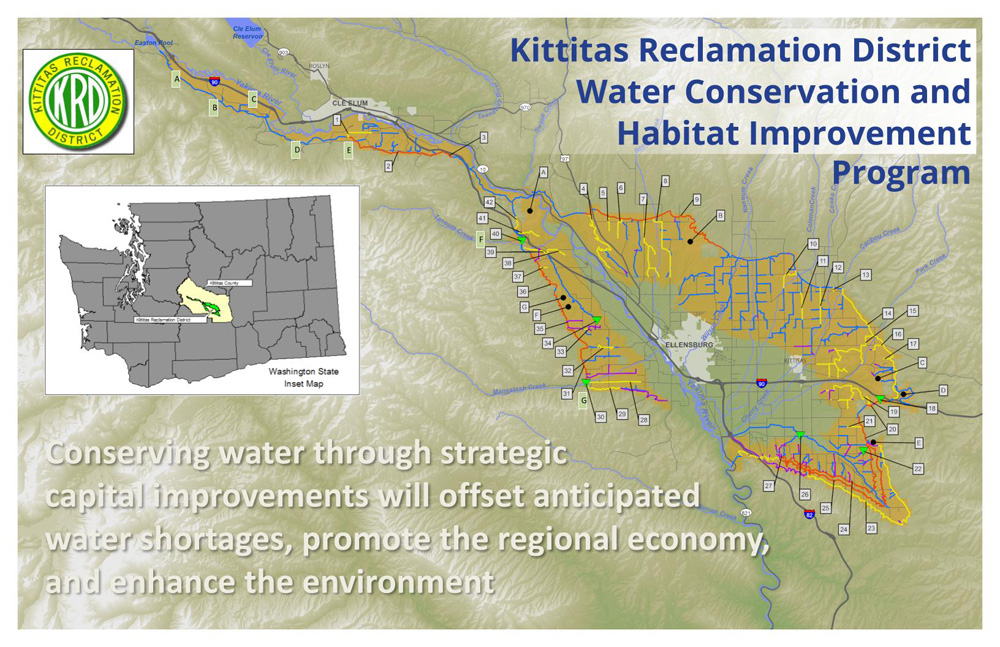
Infographic: Kittitas Reclamation District
Not only is the coalition Eberhart belongs to about as unlikely as they get—it’s made up of long-time adversaries who have battled over the basin’s water for decades—this improbable group is using dams to help rather than hinder salmon.
The idea flouts conventional environmental wisdom, which sees dams and salmon—like oil and water—as two things that simply don’t mix.
And not without reason.
Creating artificial currents
The Pacific Northwest’s salmon populations are a fraction of their historic numbers, and dams are a leading cause.
Salmon are anadromous, meaning that although the fish spend most of their lives in the ocean, they start and end their lives in freshwater streams, rivers and lakes.
Dams on these waterways block adult salmon from returning to their freshwater spawning grounds.
They also block juveniles traveling from their freshwater nurseries out to their new life at sea.
In addition, the turbines of hydroelectric dams increase fish mortality.
Dams also slow water flows, creating artificial “slack water.” While this has its benefits, like making the Columbia River significantly easier to navigate by barge, this slack water has been linked to water temperatures that are unhealthy or even lethal for salmon.
Slack water also increases predation. And it makes reaching the ocean more difficult for juvenile salmon that used to ride swift river currents out to sea.

New seasons: Lake Easton Dam on the Yakima River was constructed in the 1920s. A fish passage was added in the 1980s. Now its reservoir may come in handy for managed flows. Photo: Nathan Gilles
Nonetheless, attitudes about dams are changing.
Scientists are now investigating how dams, specifically storage dams and their reservoirs, can be used to create artificial stream and river flows that mimic natural ones.
This ability could be essential in the future, scientists argue, because climate change is expected to significantly alter natural hydrology the world over.
Independent of this scientific work, in places like the Yakima Basin others are already experimenting with creating artificial flows.
“Storage is a key piece to all this,” Eberhart says, “because if we didn’t have storage, we wouldn’t have the opportunity to keep these streams hydrated during years like this when the fall rains just did not come.”
Looking back at the coho in the stream, his point hits home.
The water flowing in front of us is being directed into the stream via a large pipe from a nearby irrigation canal. What’s more, the water in the canal is being intentionally released from two nearby reservoirs.
All of this is for fish.
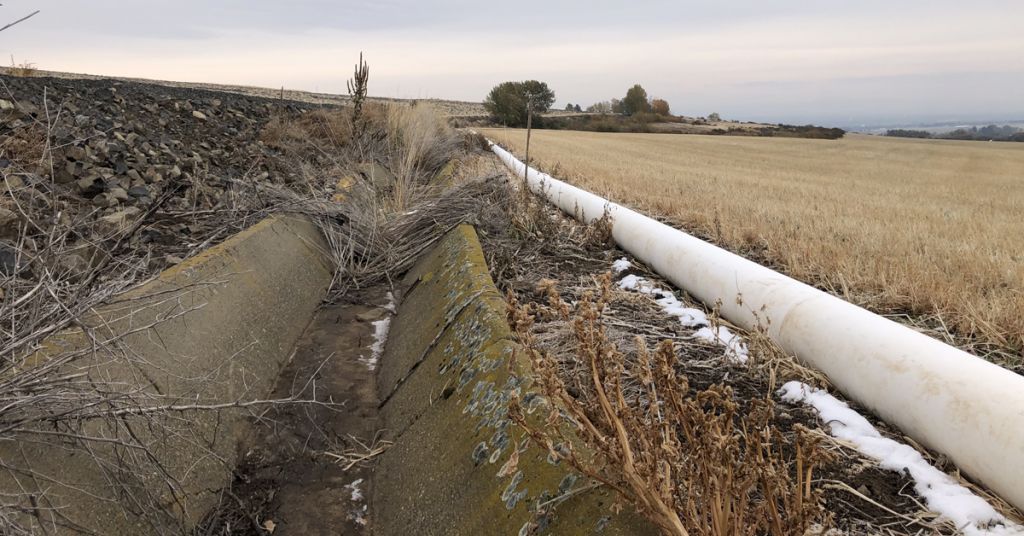
Ditching ditches: Water-saving pipes are replacing irrigation trenches, which are prone to water loss through evaporation. Photo: Nathan Gilles
As the water in the stream rises, our patient coho goes for it. She leaps out of her pool and skips along the stream’s surface, splashing water and contorting her body back and forth in an effort to get over that low spot.
She’s a fish out of water, to be sure, but she’s graceful, like a dancer falling. Her temporary flight reveals her body is gray and pink in color. She has a barely noticeable hook to her jaw and no hump to her back, all signs she is female.
Eberhart lets out a whoop of excitement.
Past the stream’s low spot, our coho moves under a nearby bridge and into deeper water, where she meets another coho.
The two swim side-by-side, their bodies appearing to touch on and off. Is this a potential mate?
It’s hard to tell given the water’s depth, but it still feels like a private moment. I look away.
Yakama Nation and salmon recovery
The Yakima River Basin has five major reservoirs with dams attached to them.
There are also a series of smaller dams throughout the basin. Some of these have reservoirs. Some divert water directly from the Yakima and other basin rivers. Some produce hydropower.
The majority of the basin’s dams were built without working fish passages—engineering structures, such as fish ladders, that allow salmon to migrate past.
As a member of the Yakama Nation, Phil Rigdon knows this all too well.
“The reservoirs, yes, they have always had a negative context to certain species, like sockeye,” says Rigdon, interim tribal administrative director and superintendent for the Department of Natural Resources for the Yakama Nation. “Some of the best habitat for salmon is above these reservoirs that have been blocked for a hundred years.”
A case in point, says Rigdon, is Bumping Lake, a lake turned reservoir east of Mount Rainier.
When the reservoir and the dam holding back its waters were completed in the early 20th century, the Yakima Basin’s last sockeye were blocked, according to Rigdon and others. After that, sockeye no longer appeared in the basin.
This is called “local extinction” or “extirpation.”
And sockeye aren’t alone. Coho and summer chinook were also fully extirpated from the basin, likely due in large part to dams.
Fall and spring chinook were never fully extirpated but are still struggling.
Mid-Columbia steelhead are listed under the Endangered Species Act (ESA), as is the non-salmon species bull trout.
Pacific lamprey, which are anadromous, have also been impacted by dams.
Of course, says Rigdon, Yakima Basin dams aren’t the only reason the basin’s salmon numbers are low.
The full list of likely culprits includes habitat loss, deforestation and roads, all of which have changed the basin’s hydrology.
Activities outside the basin, including overfishing and Columbia River dams also played their part.
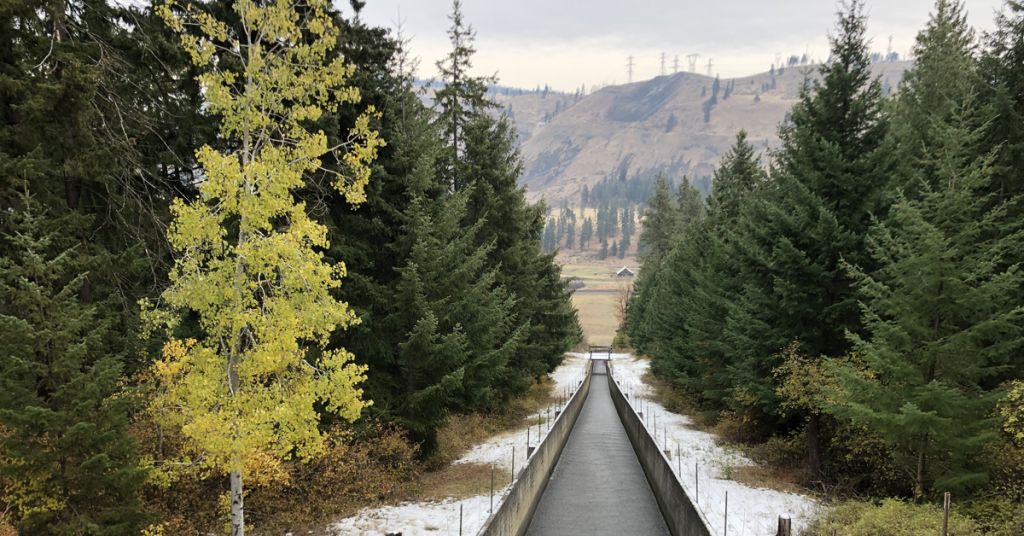
Artificial beauty: The 1146 Operational Spillway in the Kittitas Reclamation District sits on a crest above the Yakima River and leads to a 340-foot drop into the river below. Photo: Nathan Gilles
Extirpated species don’t get ESA listings or the support this brings, so the Yakama Nation has decided to reintroduce the fish themselves.
To date, the Nation’s fishery has reintroduced all three fully extirpated salmon species, and they have fishery programs in place for the basin’s other fish as well.
“We have always been the ones who have advocated on behalf of the fish, and that’s always been where our priorities have led us,” says Rigdon.
And right now, he says, this has led the Yakama Nation to reconsider the basin’s dams and reservoirs as a tool to help salmon instead of as a hindrance. This includes expanding reservoir storage for fish.
The first reservoir to have this done is Cle Elum Lake, another lake turned reservoir.
Cle Elum Lake
After watching the coho, Eberhart and I drive along winding roads surrounded by forest until we reach Cle Elum Dam and Lake.
Whereas the drive to the reservoir felt closed in, the view as we come upon the reservoir is strikingly different: wide open and breathtaking.
About eight miles long and at least a mile wide, Cle Elum Lake is the largest of the Yakima Basin’s five major reservoirs, holding roughly 436,900 acre-feet of water. And it’s only getting bigger.
As we walk up to the reservoir, Eberhart and I see that Cle Elum Dam is under construction. They’re raising the height of the dam by three feet.
This will create a “pool raise” that will add an additional 14,600-acre feet of water, all of which—remarkably—has been earmarked for fish using Yakama Nation water rights tied to their treaty with the federal government.
Right now, this water is notable for its absence.
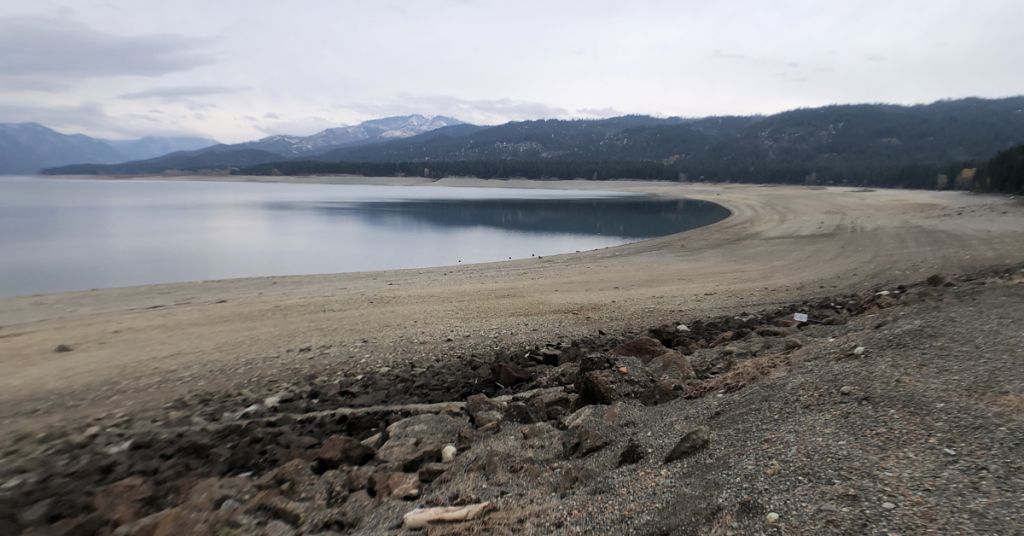
Uplifting experience: Increasing the height of its dam will raise water levels in Cle Elum Lake. Photo: Nathan Gilles
In front of us is what looks like a beach at high tide. The space set to be filled with salmon-sustaining water has been cleared bare around the reservoir.
Cle Elum is also having fish passages put in, step-like structures near the dam’s intake that are designed to accommodate the out migration of juvenile salmon when the reservoir is at different levels. (Returning adults will still need to be trapped and hauled in, which is currently being done.)
Fish passages are also planned for all four other major reservoirs in the basin.
But while Rigdon and the Yakama Nation want Cle Elum expanded, they also want some dams removed.
And they’re having success. In 2021, Nelson Dam on the Naches River north of the city of Yakima was removed to aid fish migration.
More water promises than water
Cle Elum Lake might be the basin’s largest artificial reservoir, but it’s not the basin’s largest reservoir, not by a long shot.
The basin’s largest reservoir is a natural reservoir: mountain snow, or snowpack.
As the climate warms, the Pacific Northwest is predicted to receive less and less snowpack, which will likely lead to water shortages for both fish and farms.
For this reason, Eberhart, Rigdon and the coalition they belong to are pushing for more reservoirs in their basin. They want to capture the water that was once stored as snow and release it when it’s needed for both salmon and irrigation.
They’re not the only ones.
“The system was designed in the last century,” says Thomas Tebb, director of the Office of the Columbia River for the State of Washington’s Department of Ecology. “And it was designed largely on having snowpack. Snowpack has provided, essentially, our sixth reservoir.”
“There’s a growing realization that maintaining natural flow regimes in river systems is becoming more difficult.” —Julien Olden, University of Washington
Like much of the American West, the Yakima Basin has built its water infrastructure—its reservoirs, canals and even its water rights—based on having reliable snowpack that accumulates during the cool months and melts during the warm ones.
In this way, mountain snow has acted like a natural reservoir.
“I believe we have about a million acre-feet of surface water storage, but about 2.3 million acre-feet of water contracts that need to be served,” says Tebb.
In other words, there’s more water locked up in snow than there is in all five human-made reservoirs.
When water rights were created—when it was decided how much water could be divvied out to how many rights holders—that total pool of water included water from snow.
The problem is that snow hasn’t always shown up.
Learning to cooperate
Low snowpack years have produced water shortages and led to conflict, kicking off drawn out court battles over water.
In November 2021, the Yakima Basin completed a decades-long adjudication process over water rights.
But the big court battles ended well before then.
The change occurred, according to Rigdon, when he started working with a local irrigation district manager to oppose the construction of a large new dam and reservoir called Black Rock (briefly highlighted in a recent New York Times story).
While Black Rock was never built, something else was: cooperation. The basin’s former adversaries started working together to solve their common water needs.
“In the Yakima Basin, I think we are very fortunate that we moved away from the old battle lines conversation,” says Rigdon. “You’re seeing the type of work and discussion and science being built to really take on the challenges that we face and that’s exciting.”
More dams?
Common opposition to Black Rock also helped launch the Yakima Basin Integrated Plan—“YIP” for short. Tebb oversees YIP for Ecology, working closely with the Bureau of Reclamation, which ultimately oversees the management of existing dams and reservoirs as well as the construction of new ones.
Nearly everything related to water in the Yakima Basin falls under the umbrella of YIP—including the Cle Elum pool raise and the Nelson Dam removal.
However, YIP is more than a government-run entity.
Involving face-to-face negotiations and compromises, YIP has reportedly been a highly collaborative effort representing the will of its participants. According to everyone interviewed for this story, including Tebb, YIP has been driven largely by its stakeholder working group.
“They [working group participants] have really led the charge in terms of conservation, storage, fish passage,” says Tebb.
The working group includes Rigdon and Eberhart as well as representatives from local municipalities, state and federal fisheries and multiple irrigation districts. Nonprofit environmental organizations have also been involved.
These diverse participants now support more storage, the construction of more dams and reservoirs, and see it as important for a future with less snowpack.
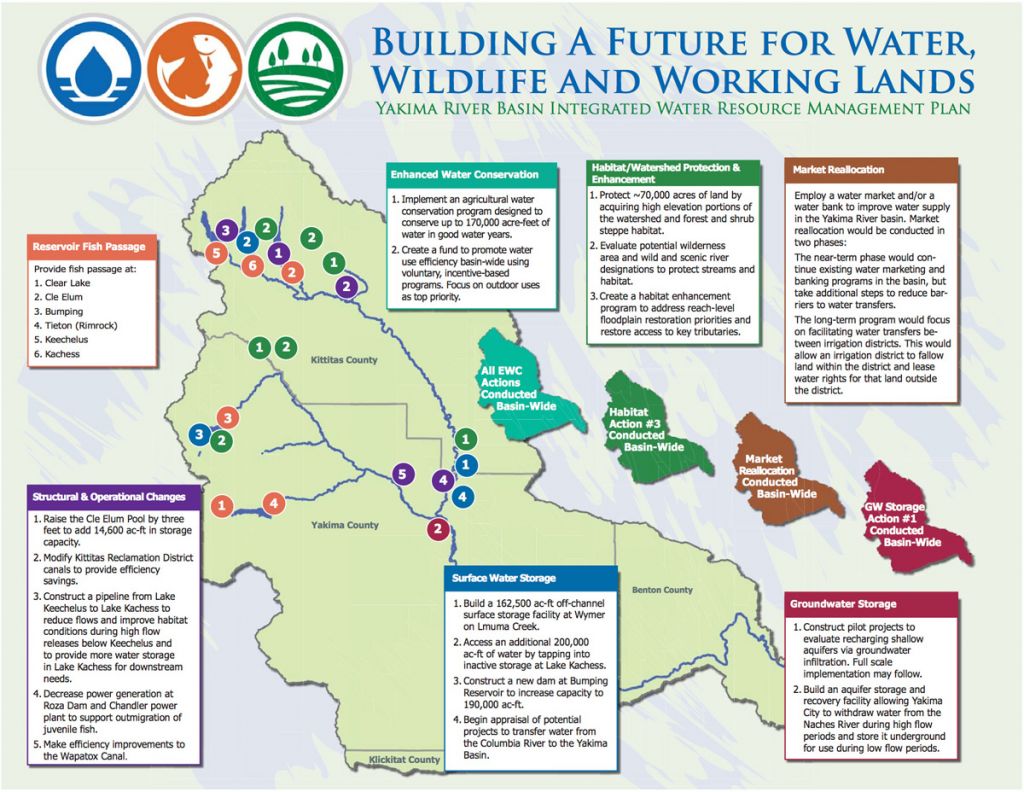
Infographic: Washington State Department of Ecology
Tebb says YIP hopes to solve the challenge of less snowpack in large part by building more reservoir storage.
“So, we do agree that storage clearly is going to be an integral part of our ability to adjust flows [in a future with less snowpack],” says Tebb, “and not just for agricultural and municipal purposes but really for that opportunity to use some of this storage for fishery purposes. And we’re excited that the Cle Elum pool raise is really that first down payment on water for fish.”
Beyond the Cle Elum pool raise, YIP includes plans to expand Bumping Lake.
There are also plans to build a new reservoir, called Wymer, near the Lmuma Creek Recreation site south of Ellensburg, Wash.
However, the Wymer project appears to be on hold for now and the expansion of Bumping could be years into the future.
Eberhart is also putting together plans to build another new reservoir in his district at the current site of Springwood Ranch.
There’s even talk about building reservoirs in the mid to lower basin. The water from these projects will be set aside for both fish and farmers.
“Designer flows,” climate change
On my tour, I would see stream after stream that used to run, but no longer do.
While the scientific literature around this type of work, referred to as “designer” or “managed” flows, is dense, the idea behind it is pretty straightforward: through the selective release of water from dams and reservoirs, artificial or “designer” flows can be created that mimic natural flows.
Under future climate change, being able to recreate something like a natural flow could be a game-changer. That’s because as snowpack disappears, it’s not just the amount of water that’s lost that’s important, it’s also the timing of the runoff.
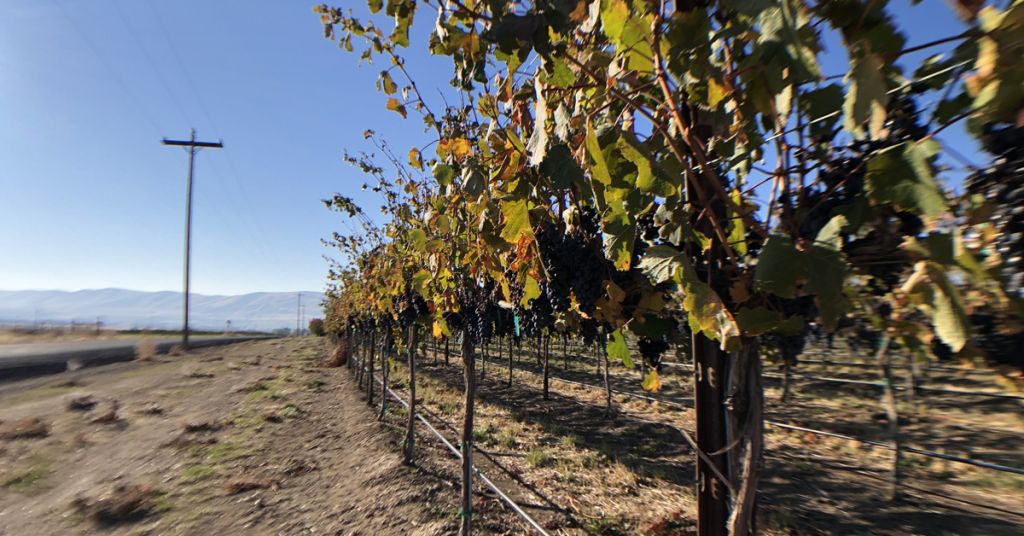
Growing issue: As snow pack dwindles, getting crops the water they need becomes more politically tricky. Photo: Nathan Gilles
In the future, peak flows—when water levels are at their highest—are predicted to come earlier in the year.
For instance, by the end of this century, peak flows on the mainstem of the Yakima River near Kiona, Wash., could come as early as February, according to research from the University of California, Merced.
Historically, peak flows for that site have come in May. This system out of sync could spell disaster for growing crops and migrating fish.
“Dams, although historically viewed as being bad in terms of their negative ecological implications, might actually provide us an important tool to adapt to these changing flow conditions,” says Julian Olden, a professor of fisheries sciences at the University of Washington, who studies designer flows.
While Olden isn’t involved in YIP and chose not to comment on any work being done in the Yakima Basin, he says designer flows are being investigated for their ability to restore ecosystem functions, including fish migrations as the climate changes.
“There’s been this growing realization that looking to the future, maintaining or restoring natural flow regimes in river systems is becoming increasingly more difficult,” says Olden.
But scientists investigating designer flows have also examined ways to balance natural ecosystem processes with human needs.
In some cases, says Olden, research suggests that returning to a completely natural hydrology might not deliver the most benefits for either humans or ecosystems.
This has made designer flows controversial, putting them “under intense scrutiny,” according to Olden.
However, though counterintuitive, the idea that natural could no longer be best is finding some unexpected adherents.
Environmentalists get on board
The hydrology of the Yakima Basin is far from natural.
Although the streams Eberhart showed me most likely would have been dry this year due to a late start to the fall rains, many of them were dry in years past because water was diverted away from them.
But being in an unnatural system, one that’s under human control, might actually be an advantage in the future.

Power of compromise: Scott Revell of central Washington’s Roza Irrigation District says irrigators’ “street cred” with the Yakama Nation and other fish advocates “went through the roof” when they agreed to divert upper Yakima Basin water for fish management during the drought of 2015. Photo: Nathan Gilles
“In a heavily developed and altered system like the Yakima Basin is—where returning to a pre-engineered natural system is not going to happen—it makes sense to take advantage of dams’ ability to change flows to try to get back to something like a natural flow,” says Michael Garrity, Energy, Water and Major Projects division manager for Washington Department of Fish and Wildlife.
An environmental lawyer by training, Garrity previously worked for American Rivers, an environmental nonprofit. Working for American Rivers, Garrity became involved with YIP.
In the beginning, Garrity says, he was skeptical that dams and reservoirs could be used to help fish.
He was also torn because expanding Bumping Lake reservoir would mean flooding forests to save salmon. Ultimately, he says, he was won over by arguments about lost snowpack, promises to build fish passages and YIP’s collaborative process.
“It was really something for American Rivers to be seriously entertaining the possibility of new surface storage,” says Garrity. “I was convinced, and I convinced the American Rivers folks in Washington D.C. that it made sense to be at the table and ultimately that the package that was negotiated [through YIP] made sense.”
Lisa Pelly, director of the Washington Water Project for the fishing and environmental advocacy group Trout Unlimited, has also been heavily involved in YIP. She and Trout Unlimited came to support more reservoir storage as a way to help the basin’s salmon, though she too was initially skeptical.
“We [Trout Unlimited] didn’t exactly walk into the process saying, ‘let’s build two big dams [Wymer and Bumping],’” says Pelly.
Pelly says snowpack predictions and talking with YIP participants, including irrigators, led her and her organization to determine that building more storage in the Yakima Basin made sense.
However, she stresses, what works for the Yakima Basin might not work somewhere else.
“Depending on the scenario, [Trout Unlimited] would support new storage where appropriate and, where appropriate, let’s get these dams out of there and allow these rivers to run like they should,” she says.
Mixed forecast
As Eberhart and I leave Cle Elum Lake and drive back to the KRD offices in Ellensburg, I’m feeling both impressed and somewhat hopeful for the future.
I’m impressed by the human relationships and cooperation I’ve seen. I’m impressed that such a diverse group could learn to work together. And I’m impressed by the size and complexity of the human engineering, as well as the clever tweaks that are upgrading 20th-century infrastructure for the 21st.
And yet, I can’t help but think they’re missing something.
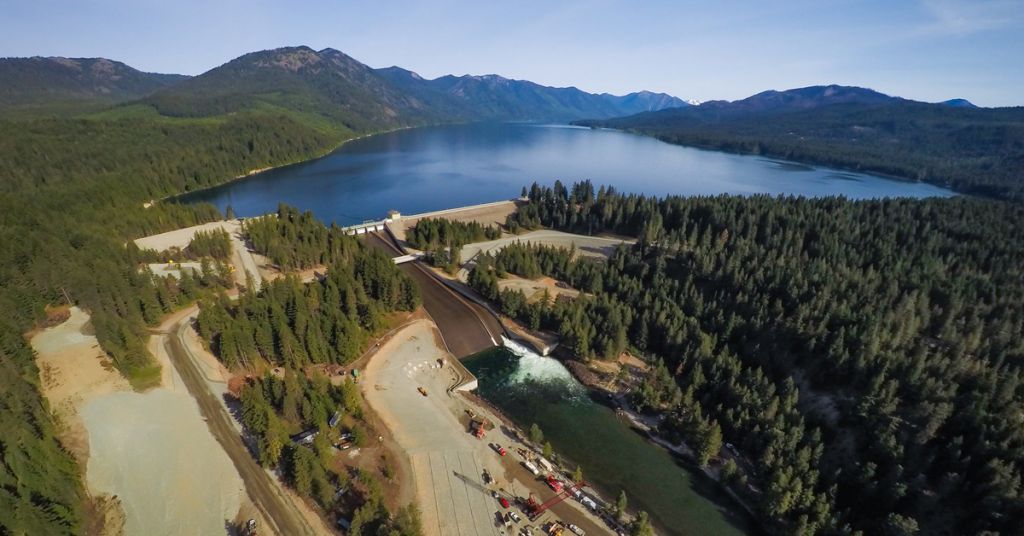
Ripple in still water: Cle Elum Lake looks placid. Big plans are afoot. Photo: Kirsten Strough/BOR
Large reservoirs can absorb a lot of heat.
But fish need cool waters not just flowing ones. This will have to be dealt with in a warmer world.
What’s more, YIP seems largely based around losing mid-elevation snowpack in the future.
But what if the predictions are wrong? What if the basin also loses its high-elevation snowpack? And what if greenhouse gas emissions aren’t cut back enough?
The basin’s salmon might be able to live with short-term climate change, but living through thousands of years of climate change, as some predictions suggest could happen, seems highly unlikely.
I bring up my concerns with Eberhart.
He responds with a somewhat defensive answer that includes multiple engineering solutions that might help and the importance of “working together” and “not fighting all the time.” Then he stops, laughs and reconsiders what to say.
“Failure is not an option,” says Eberhart.
Nathan Gilles is a freelance science writer based in Vancouver, Washington.




